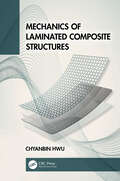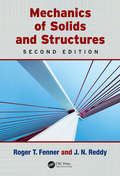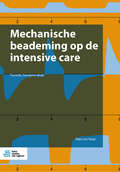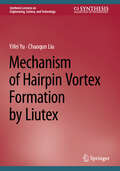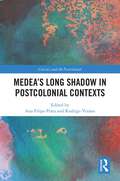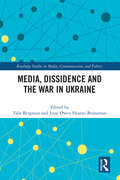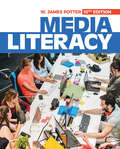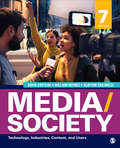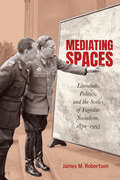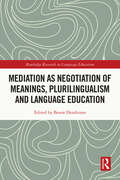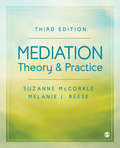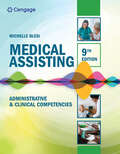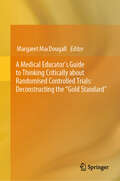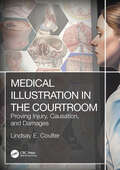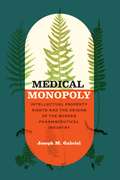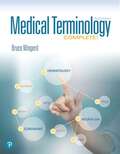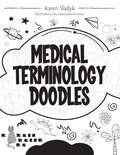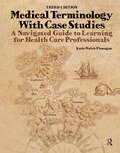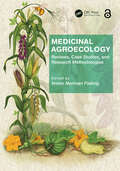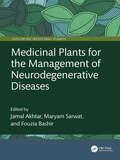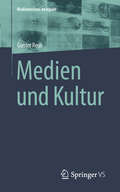- Table View
- List View
Mechanics of Laminated Composite Structures
by Chyanbin HwuIn this textbook for students of laminated composite materials, composite structures, and anisotropic elasticity, Chyanbin Hwu draws on more than three decades of research and applications experience to provide a leading resource on many unique topics related to laminated composite structures.This book introduces the mechanical behavior of laminated composite materials and provides related theories and solutions. All basic structural elements such as beams, plates, and shells are described in detail. Further contents include composite sandwich construction and composite wing structures. To connect with practical engineering applications and analyze more complicated real structures, numerical methods and their theoretical basis in anisotropic elasticity are also included. Advanced topics addressed include solutions for magneto-electro-elastic laminated plates; Green’s functions for thick laminated plates and beams; typical thick laminated beams; theory for general laminated composite shells; sandwich beams, plates, and cylindrical shells as well as delaminated composite sandwich beams; modeling and analysis of composite wing structures; complex variable theories of anisotropic elasticity and the related Green’s functions; and numerical methods such as finite element method, boundary element method and meshless method. Through this book, readers will learn not only the mechanics of laminated composite structures but also anisotropic elasticity and some popular numerical methods.This textbook is vital for advanced undergraduate and graduate students interested in the mechanics of composite materials, composite structures, and anisotropic elasticity, such as aerospace, mechanical, civil, and naval engineering; applied mechanics; and engineering science. It is also useful for engineers working in these fields and applied mathematicians and material scientists.
Mechanics of Solids and Structures (Applied and Computational Mechanics)
by Roger T. Fenner J.N. ReddyA popular text in its first edition, Mechanics of Solids and Structures serves as a course text for the senior/graduate (fourth or fifth year) courses/modules in the mechanics of solid/advanced strength of materials, offered in aerospace, civil, engineering science, and mechanical engineering departments. Now, Mechanics of Solid and Structure, Seco
Mechanische beademing op de intensive care
by Hans ter HaarDit boek geeft een volledig en evidence-based overzicht van alle facetten van mechanische beademing. Het biedt de zorgprofessional inzicht in de verschillende beademingsvormen; de werkingsmechanismen, hoe ze optimaal kunnen worden toegepast, welke invloed ze uitoefenen op de longen en de rest van het lichaam en wat de gevolgen hiervan kunnen zijn. Mechanische beademing op de intensive care behandelt onder meer anatomie, fysiologie, pathofysiologie, respiratoire insufficiëntie, beademingsvormen, curves en loops, het instellen van de beademingsmachine, beademingsstrategieën en -technieken, complicaties en andere gevolgen, capnografie en ontwennen van beademing. Het boek gaat waar nodig diep op de materie in met inzichten uit de meest recente studies. Mede dankzij de vele afbeeldingen is het zeer leesbaar en toegankelijk.Nieuw in deze editie zijn onder andere Covid-19 ARDS, patient-self-inflicted-lung-injury, airway pressure release ventilation, mechanical power, gepersonaliseerd beademen, en nieuwe technieken om de mate van longstress te bepalen.Dit boek is een must voor iedereen die met mechanische beademing werkt, van IC-verpleegkundigen (in opleiding), beademingsspecialisten (in opleiding), tot artsen in opleiding en vele andere professionals die met mechanische beademing werken.Hans ter Haar is werkzaam als IC-verpleegkundige en beademingsspecialist in Isala Zwolle.
Mechanism of Hairpin Vortex Formation by Liutex (Synthesis Lectures on Engineering, Science, and Technology)
by Yifei Yu Chaoqun LiuThis book presents the importance of the mechanism of hairpin vortex formation to understanding flow transition, turbulence, and flow control. This book blends direct numerical simulation (DNS) and mathematical analysis with experiments to create a foundation for understanding turbulence. The authors discuss hairpin vortex as a main component of transitional flow and turbulent flow. In addition, Liutex is utilized and described as a theoretical system that presents valid tools for turbulence research. Readers are exposed to understanding 3D and non-linear instability; the Lambda vortex formation; sweeps, ejections, and shear instability; the Kelvin-Helmholtz instability and vortex ring formation; and turbulence generation and sustenance.
Medea’s Long Shadow in Postcolonial Contexts (Classics and the Postcolonial)
by Ana Filipa PrataThis interdisciplinary volume explores the ancient Greek myth of Medea and its global analogues found in other mythic and folk tales of deadly, exiled women, such as those of La Malinche and La Llorona, examining the connections between these figures and their depictions from antiquity to modernity.The book considers the figure of the foreign woman, her exile, fratricide, and infanticide, in its ancient Greek form and in global, postcolonial receptions in a range of media, including drama, film, novels, and the visual arts. The chapters illuminate the contradictions of considering the classical Medea as a central reference point for analysis of other female figures from peripheral territories, while simultaneously acknowledging the insights that such comparisons can yield. Emphasizing the ways in which Medea’s seditious nature enables the establishment of an extensive and heterogeneous intertextual network with other mythic characters who represent a similarly disruptive role in their specific local historical and cultural contexts, the book argues for a comparative analysis that is equally attentive to myths and folk tales from all regions. These essays – by scholars of classics, comparative and world literatures, and postcolonial studies – represent a plurality of perspectives from different academic contexts in Africa, Latin America, North America, and Europe and examine how different cultures have depicted women, foreigners, crime, and abjection. The foundations of Greek myth and subsequently of the classical tradition itself are interrogated from a postcolonial perspective. In tracing the portrayals of Medea and other mythic women through the overlapping features of different female characters and plots, and intertwining local cultural and literary materials with broader debates, this volume challenges Eurocentric narratives of power and cultural domination, and works to decentralize the discussion of Medea from the exclusive domain of classical studies.Medea’s Long Shadow in Postcolonial Contexts will be of interest to students and scholars working on Greek tragedy and its reception, as well as to those studying postcolonial and global approaches to literature, culture, and gender studies.
Media, Dissidence and the War in Ukraine (Routledge Studies in Media, Communication, and Politics)
by Tabe Bergman Hearns-Branaman, Jesse OwenThis volume examines the global media coverage of the armed conflict in Ukraine, focusing on the marginalization of dissident perspectives in the West and the information quality and diversity on social media.Along with presenting original, empirical studies on how mainstream media in countries as diverse as Israel, the Czech Republic, Ghana, and the Netherlands have covered the conflict between NATO and Russia since 2022, this book sheds light on the role of the state and the media in policing the boundaries of permissible thought on the conflict in the West, as well as in Russia and Ukraine. It also delves into the war’s representation on prominent social media platforms.Written by a diverse group of international researchers, this multifaceted volume offers new perspectives and insights on the reporting of the ongoing conflict. It will interest scholars of international communication and media, foreign policy and international politics, war and conflict, content analysis, and journalism.
Media Literacy
by W. James PotterMedia Literacy teaches students how to navigate through the overwhelming flood of information found in today’s media-saturated world. Drawing from thousands of media research studies, author W. James Potter explores key components to understanding the fascinating world of mass media. Potter presents examples and facts to help students understand how the media operate, how they attract attention, and how they influence the public. Chapters conclude with exercises to help readers apply the material to everyday life and improve their media literacy. The Tenth Edition integrates a stronger focus on digital media, features a streamlined organization, and updates facts to keep readers informed on the rapidly changing media phenomenon.
Media Literacy
by W. James PotterMedia Literacy teaches students how to navigate through the overwhelming flood of information found in today’s media-saturated world. Drawing from thousands of media research studies, author W. James Potter explores key components to understanding the fascinating world of mass media. Potter presents examples and facts to help students understand how the media operate, how they attract attention, and how they influence the public. Chapters conclude with exercises to help readers apply the material to everyday life and improve their media literacy. The Tenth Edition integrates a stronger focus on digital media, features a streamlined organization, and updates facts to keep readers informed on the rapidly changing media phenomenon.
Media/Society: Technology, Industries, Content, and Users
by William Hoynes Clayton Childress David R. CroteauWinner of the 2022 Textbook & Academic Authors Association′s The McGuffey Longevity Award Media/Society: Technology, Industries, Content, and Users helps students understand the relationship between media and society and gets them to think critically about recent media developments. Authors David Croteau, William Hoynes, and new co-author Clayton Childress take an interdisciplinary approach with a sociological focus to answer questions like How do people use the media in their everyday lives? and How has the evolution of technology affected the media and how we use them? The Seventh Edition incorporates the latest scholarship and data that address enduring media topics, as well as new concerns raised by the role of digital platforms, the impact of misinformation online, and the role of media during the COVID-19 pandemic.
Media/Society: Technology, Industries, Content, and Users
by William Hoynes Clayton Childress David R. CroteauWinner of the 2022 Textbook & Academic Authors Association′s The McGuffey Longevity Award Media/Society: Technology, Industries, Content, and Users helps students understand the relationship between media and society and gets them to think critically about recent media developments. Authors David Croteau, William Hoynes, and new co-author Clayton Childress take an interdisciplinary approach with a sociological focus to answer questions like How do people use the media in their everyday lives? and How has the evolution of technology affected the media and how we use them? The Seventh Edition incorporates the latest scholarship and data that address enduring media topics, as well as new concerns raised by the role of digital platforms, the impact of misinformation online, and the role of media during the COVID-19 pandemic.
Mediating Spaces: Literature, Politics, and the Scales of Yugoslav Socialism, 1870–1995
by James M. RobertsonThroughout the twentieth century in the lands of Yugoslavia, socialists embarked on multiple projects of supranational unification. Sensitive to the vulnerability of small nations in a world of great powers, they pursued political sovereignty, economic development, and cultural modernization at a scale between the national and the global – from regional strategies of Balkan federalism to continental visions of European integration to the internationalist ambitions of the Non-Aligned Movement.In Mediating Spaces James Robertson offers an intellectual history of the diverse supranational politics of Yugoslav socialism, beginning with its birth in the 1870s and concluding with its violent collapse in the 1990s. Showcasing the ways in which socialists in Southeast Europe confronted the political, economic, and cultural dimensions of globalization, the book frames the evolution of supranational politics as a response to the shifting dynamics of global economic and geopolitical competition. Arguing that literature was a crucial vehicle for imagining new communities beyond the nation, Robertson analyzes the manuscripts, journals, and personal correspondence of the literary left to excavate the cultural geographies that animated Yugoslav socialism and its supranational horizons. The book ultimately illuminates the innovative strategies of cultural development used by socialist writers to challenge global asymmetries of power and prestige.Mediating Spaces reveals the full significance of supranationalism in the history of socialist thought, recovering a key concern for an era of renewed geopolitical contestation in Eastern Europe.
Mediation as Negotiation of Meanings, Plurilingualism and Language Education (Routledge Research in Language Education)
by Bessie DendrinosBringing together the voices of a diverse group of scholars and language professionals, this edited collection, concerned with the cultivation of plurilingualism in multilingual educational settings, builds on the theory and practice of linguistic and cultural mediation both as curricular content and social practice.The chapters view mediation as an important aspect of communication which involves dynamic, purposeful interactivity, implicating social agents in the negotiation and construction of socially situated meanings across different languages and within the same language. Theoretically informed chapters present views on mediation as well as contributors’ research and project outcomes in educational interventions. They also describe how mediation has been incorporated in educational practices and how it materialises in social contexts. Ultimately, this book makes the case for why mediation constitutes a key competence to be developed for active global and local citizenry in today’s societies where there is an increased rate of knowledge acquisition and exchange.Presenting research from classrooms and other multilingual environments, this book offers concrete suggestions for the development of language users/learners’ ability to mediate within and across languages. It will appeal to scholars, researchers and postgraduate students in the fields of language and education, education policy and politics, bilingualism and plurilingualism more generally. Curriculum designers may also find the volume of use.
Mediation Theory and Practice
by Melanie J. Reese Suzanne McCorkleMediation Theory and Practice, Third Edition introduces students to the process of mediation by using practical examples that show students how to better manage conflicts and resolve disputes. Authors Suzanne McCorkle and Melanie J. Reese help students to understand the research and theory that underlie mediation, as well as provide students with the foundational skills a mediator must possess in any context, including issue identification, setting the agenda for negotiation, problem solving, settlement, and closure. New to the Third Edition: Expanded content on the role of evaluative mediation reflects the latest changes to the alternative dispute resolution field, helping students to distinguish between various approaches to mediation. Additional discussions around careers in conflict management familiarize students with employment opportunities for mediators, standards of professional conduct, and professional mediator competencies. New activities and case studies throughout each chapter assist students in developing their mediation competency.
Mediation Theory and Practice
by Melanie J. Reese Suzanne McCorkleMediation Theory and Practice, Third Edition introduces students to the process of mediation by using practical examples that show students how to better manage conflicts and resolve disputes. Authors Suzanne McCorkle and Melanie J. Reese help students to understand the research and theory that underlie mediation, as well as provide students with the foundational skills a mediator must possess in any context, including issue identification, setting the agenda for negotiation, problem solving, settlement, and closure. New to the Third Edition: Expanded content on the role of evaluative mediation reflects the latest changes to the alternative dispute resolution field, helping students to distinguish between various approaches to mediation. Additional discussions around careers in conflict management familiarize students with employment opportunities for mediators, standards of professional conduct, and professional mediator competencies. New activities and case studies throughout each chapter assist students in developing their mediation competency.
Medical Assisting: Administrative and Clinical Competencies
by Virginia Ferrari Michelle BlesiStrengthen your knowledge base as well as the critical skills and behaviors needed to become a successful entry-level medical assistant with Blesi's MEDICAL ASSISTING: ADMINISTRATIVE AND CLINICAL COMPETENCIES, 9E. Clear and easy to understand, this streamlined edition now includes a complete, updated section on the structure and function of body systems with current medical terminology presented in context. Updates highlight the latest information in nutrition, the Affordable Care Act (ACA), ICD-10 and electronic health records. Expanded content focuses on increasing your personal effectiveness as you study professionalism, teamwork and time management. New chapters also discuss geriatrics and mental health -- topics of growing importance. You examine the latest procedures as you increase your general, administrative and clinical competencies. MindTap digital resources help you further develop a competitive advantage as you pursue a career in medical assisting today.
A Medical Educator's Guide to Thinking Critically about Randomised Controlled Trials: Deconstructing the "Gold Standard"
by Margaret MacDougallDrawing on the statistical and philosophical expertise of its authors, this book is designed to improve understanding and use of randomised controlled trials (RCTs) among health professionals. It is intended for use primarily by medical educators involved in teaching statistics and evidence-based medicine (EBM) to medical students, junior doctors and other health professionals. However, each of the chapters serves a wider range of interests, including the practical needs of physicians in interpreting research evidence to support clinical decision making and the teaching needs of philosophers of medicine who want to more fully appreciate how RCTs work in practice and provide engaging examples for their students. Rather than compete with the proliferating methodological literature on RCT designs, this book focuses on cultivating a healthy skepticism among developing health professionals to support critical appraisal of their own and published work on RCTs at a fundamental level, including through a more informed understanding of the place of subgroup analyses in sound statistical inference. Management of the positive predictive value in the statistical analysis of RCT findings is included as an important topic for contemporary medical curricula. In comparing RCTs with non-randomised studies, a search for empirical evidence for the superiority of RCTs is initiated, pointing to the need for further work to confirm what form this evidence should take.Medical educators will find a wealth of reasons to encourage their students to think more critically about how the RCT operates in practice as a gold standard.
Medical Illustration in the Courtroom: Proving Injury, Causation, and Damages
by Lindsay E. CoulterMedical Illustration in the Courtroom: Proving Injury, Causation, and Damages educates the reader on how to communicate science visually—in personal injury, medical malpractice, criminal, and forensic cases—by creating art that utilizes medical records, radiographs, and computer software. Medical illustration bridges the gap between complex technical, medical, and scientific concepts to clearly illustrate, and explain visually, a medical condition, negligence, or the causation of an injury or death to the lay person. Medical artists are frequently challenged with illustrating injuries and medical conditions that can’t be seen by the naked eye. And while using medical photography and imaging for illustrative purposes can be helpful, to an untrained eye it can often be unclear or confusing. This is where the medical illustrator enters the equation. There are often patients who have recovered from an injury or infection that appear in good health. However, should an unforeseen injury or fatality happen, medical illustrators can reveal to people what’s actually going on inside the person, an invaluable asset to attorneys in the courtroom—especially for personal injury and medical malpractice cases. While many attorneys utilize medical artists, nonvisual people don’t always recognize the value of demonstrative aids until they see them first-hand.When attorneys and their clients enlist the aid of medical artists, it quickly becomes apparent that properly conceived and executed artwork is invaluable to illustrating the facts—and medical impacts—of any number of scenarios: homicides by shooting, stabbings, vehicular accidents, in addition to medical malpractice and personal injuries resulting from surgery or possible negligence.Presenting a myriad of services and computer technologies that can be utilized, Medical Illustration in the Courtroom provides demonstrative aids used in cases to illustrate personal injury and medical malpractice, employing "tricks of the trade" to create an accurate effective image. Such images are educational to attorneys, insurance adjusters, judges, and juries to help create a visual storyline, the goal being to help combine art and science to provide a clear illustration of events to help in adjudicate legal and forensic cases.
Medical Monopoly: Intellectual Property Rights and the Origins of the Modern Pharmaceutical Industry (Synthesis Ser.)
by Joseph M. GabrielDuring most of the nineteenth century, physicians and pharmacists alike considered medical patenting and the use of trademarks by drug manufacturers unethical forms of monopoly; physicians who prescribed patented drugs could be, and were, ostracized from the medical community. In the decades following the Civil War, however, complex changes in patent and trademark law intersected with the changing sensibilities of both physicians and pharmacists to make intellectual property rights in drug manufacturing scientifically and ethically legitimate. By World War I, patented and trademarked drugs had become essential to the practice of good medicine, aiding in the rise of the American pharmaceutical industry and forever altering the course of medicine. Drawing on a wealth of previously unused archival material, Medical Monopoly combines legal, medical, and business history to offer a sweeping new interpretation of the origins of the complex and often troubling relationship between the pharmaceutical industry and medical practice today. Joseph M. Gabriel provides the first detailed history of patent and trademark law as it relates to the nineteenth-century pharmaceutical industry as well as a unique interpretation of medical ethics, therapeutic reform, and the efforts to regulate the market in pharmaceuticals before World War I. His book will be of interest not only to historians of medicine and science and intellectual property scholars but also to anyone following contemporary debates about the pharmaceutical industry, the patenting of scientific discoveries, and the role of advertising in the marketplace.
Medical Terminology Complete!
by Bruce WingerdMedical Terminology Complete! takes a programmed approach to presenting the most current language of healthcare. Organized by body system, the text conveys the medical terms used in medical offices, hospitals and clinics, together with essential A&P information. You'll get step-by-step guidance in building medical terms. Word Part Reminders show you how word parts combine to form a term, while Word Part Breakdowns identify word parts. Some exercises offer word-building practice, while others use medical reports to show how medical terms are used in practice. The 4th Edition improves clinical training for students poised to a launch a healthcare career. New types of chapter-ending exercises, such as Define the Combining Form and Complete the Labels exercises, round out a comprehensive series of practice opportunities.
Medical Terminology Doodles
by Karen SladykToday's students have expressed a strong preference for multiple modes of information delivery, including visual, auditory and kinesthetic. Medical Terminology Doodles by Dr. Karen Sladyk is a unique book based on evidence that suggests that a multi-sensory approach that includes doodling can promote better knowledge retention than traditional methods in learning medical terminology.Medical Terminology Doodles offers 266 of the most common medical terms to explore and learn through doodling. By drawing or doodling related images, students will create permanent connections between the brain and the terms, as well as their root words, prefixes, and suffixes. Study hints, spelling hints, and sample illustrations are offered for each of the words, but students are also encouraged to personalize their learning by assigning meaning to the terms and creating their own “art.” Using visual cues to remember information will encourage students to review the material at hand and will also help them understand the way that terms connect to larger medical concepts. Medical Terminology Doodles is a must-have for students looking for a unique manner in which to engage with complicated scientific material. On the road to becoming a successful practitioner in the health professions, you can never underestimate the power of a doodle!
Medical Terminology with Case Studies: A Navigated Guide to Learning for Health Care Professionals
by Katie Walsh FlanaganMedical Terminology With Case Studies: A Navigated Guide to Learning for Health Care Professionals, Third Edition, is a fun, engaging, and easy-to-read resource on medical terminology for allied health students in athletic training, occupational therapy, physical therapy, and more.Featuring such memorable characters as Skully, the pirate skeleton, and Tango, his trusty parrot, Medical Terminology With Case Studies contains colorful illustrations throughout the text along with tear-out worksheets for students at the end of each chapter. The book is appropriate for students in both college and high school settings.The textbook is divided into three sections, each one covering key concepts and ideas related to medical terminology: Section I: A general overview of medical terminology, delving into its uses, purposes, and career-specific applications across specialties Section II: An in-depth examination of the specific body systems (musculoskeletal, cardiovascular, respiratory, neurological, gastrointestinal, integumentary, endocrine, urinary, reproductive, and sensory) and the associated prefixes, suffixes, and combining forms that go along with them Section III: Appendices, including medical abbreviations, ICD/CPT medical coding, and pharmacology terms Updated features in the Third Edition include: New terms throughout Updated graphics throughout New case studies New chapter on health professions Updated chapter bibliographies Included with the text are online supplemental materials for faculty use in the classroom.Combining bright, colorful characters with easy-to-read resources, Medical Terminology With Case Studies: A Navigated Guide toLearning for Health Care Professionals, Third Edition, is an invaluable terminology guide for allied health students.
Medicinal Agroecology: Reviews, Case Studies and Research Methodologies
by Immo Norman FiebrigMedicinal Agroecology: Reviews, Case Studies, and Research Methodologies presents information on applications of ‘green therapies’ in restoration towards global sustainability. These practices connect the world of medicinal plants with ecologic farming practice, creating a compassionate socio-political worldview and heartfelt scientific research towards food sovereignty and a healthier future on planet Earth. The book communicates benefits of using plant-based solutions to manage the challenges of unsustainable practices in human healthcare, veterinary medicine, agriculture, forestry, and water management. The contributions introduce advances around plants and their active components to potentially treat disease, regulate dysfunction, and balance ecosystems. These practices are explored in further depth through three sections: POLICIES AND FRAMEWORKS, INSIGHTS AND OVERVIEWS, and CASE STUDIES AND RESEARCH METHODS. Edited by Immo Norman Fiebrig, Medicinal Agroecology: Reviews, Case Studies, and Research Methodologies appeals to those in various disciplines including agriculture and agroecology, healthcare, environmental sciences, and veterinary medicine.Chapters 3 and 9 of this book are freely available as a downloadable Open Access PDF at http://www.taylorfrancis.com under a Creative Commons [Attribution-Non Commercial-No Derivatives (CC-BY-NC-ND)] 4.0 license.
Medicinal Plants for the Management of Neurodegenerative Diseases (Exploring Medicinal Plants)
by Maryam Sarwat Jamal Akhtar Fouzia BashirAgeing is the main reason for most neurodegenerative diseases, including Alzheimer’s disease (AD) and Parkinson’s disease (PD). About 10% of individuals aged ≥65 years develop AD, which continuously increases with growing age. Medicinal plants have been used for age-related neurodegenerative disorders for a long time. These plants are rich in terms of various phytochemical constituents such as flavonoids, sterols, alkaloids, saponins, and terpenoids. Different scientific studies have been carried out on these medicinal herbs, e.g., anti-inflammatory, antioxidant, and neuro-regenerative activities that may be used in the treatment of AD and other age-related diseases. These medicinal plants, e.g., Curcuma longa, Bacopa monniera, Glycyrrhiza glabra, Commiphora whighitti, and Acorus calamus L., have anti-inflammatory properties that may decrease swelling of the brain tissue in AD.Despite this, there is currently no book available in the market that provides full information on the phytochemical and medicinal uses of the medicinal plants exclusively used for the management of neurodegenerative diseases in the elderly. This book aims to provide some important and evidence-based information on the plants used for neurodegenerative diseases in the elderly, especially AD and PD, in a planned manner so the academicians, researchers, and students working in the fields of medicinal plants, plant science, chemistry, biotechnology, pharmacognosy, pharmaceuticals, biochemistry, and many other interdisciplinary subjects may benefit. This book will also be useful in identifying a few medicinal plants and their prospects for the synthesis or preparation of new drugs for neurodegenerative diseases.Features: An overview of the medicinal plants that can be helpful for neurodegenerative disorders Recent research results and some pointers for the management of neurodegenerative diseases This book serve as comprehensive information about the description, phytochemistry, actions, and medicinal use of plants that are used in neurodegenerative diseases. In addition, this book will also ease the understanding and interaction of medicinal plants used in neurodegenerative diseases.
Medicine Wheel for the Planet: A Journey Toward Personal and Ecological Healing
by Jennifer GrenzA personal journey of bringing together Western science and Indigenous ecology to transform our understanding of the human role in healing our planetI used to be an ecologist. . . . Now, I am a community gatherer, working to help bring healing beyond just the land. I am a story-listener. I am a storyteller. I am a shaper of ecosystems. I work on bringing communities together, in circle, to listen to each other. A farm kid at heart, and a Nlaka&’pamux woman of mixed ancestry, Dr. Jennifer Grenz always felt a deep connection to the land. However, after nearly two decades of working as a restoration ecologist in the Pacific Northwest, she became frustrated that despite the best efforts of her colleagues and numerous volunteers, they weren&’t making the meaningful change needed for plant, animal, and human communities to adapt to a warming climate. Restoration ecology is grounded in an idea that we must return the natural world to an untouched, pristine state, placing humans in a godlike role—a notion at odds with Indigenous histories of purposeful, reciprocal interaction with the environment. This disconnect sent Dr. Grenz on a personal journey of joining her head (Western science) and her heart (Indigenous worldview) to find a truer path toward ecological healing. In Medicine Wheel for the Planet, building on sacred stories, field observations, and her own journey, Dr. Grenz invites readers to share in the teachings of the four directions of the medicine wheel: the North, which draws upon the knowledge and wisdom of elders; the East, where we let go of colonial narratives and see with fresh eyes; the South, where we apply new-old worldviews to envision a way forward; and the West, where a relational approach to land reconciliation is realized. Eloquent, inspiring, and disruptive, Medicine Wheel for the Planet circles around an argument that we need more than a singular worldview to protect the planet and make the significant changes we are running out of time for.
Medien und Kultur (Medienwissen kompakt)
by Gunter ReusMedien bestimmen unseren Alltag in jeder Lebenslage. Viele Menschen empfinden ihre Macht aber als gefährlich für die gesellschaftliche Kultur. Gunter Reus zeigt dagegen, wie sehr ein Gemeinwesen auf der kulturellen Leistung der Massenmedien aufbaut. Der Autor bedient sich dabei eines weiten Kulturbegriffs und zeichnet nach, wie sie Errungenschaften der Menschheit historisch ausgeformt haben. Ohne Medien gäbe es keine einheitliche Sprache und keinen Austausch von Information und Wissen, wie wir ihn kennen. Es gäbe keine Ausbalancierung sozialer Interessen, keine Kontrolle von Macht, keine Orientierung auf das Gemeinwohl, kein Kunstleben. Auch im Internetzeitalter bleiben Massenmedien, bei aller notwendigen Kritik an ihren Schattenseiten, unverzichtbar als Kulturträger. Sie sorgen für die Transparenz politischen Handelns ebenso wie für die (potentielle) Teilhabe aller am Kunstgeschehen. Damit prägen sie die Kultur der Demokratie wie auch die Kultur in der Demokratie entscheidend mit.
